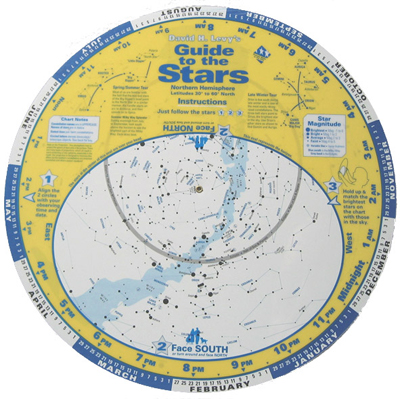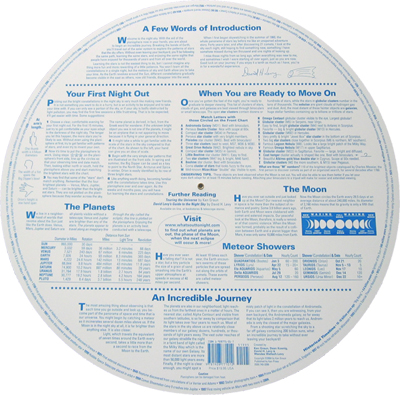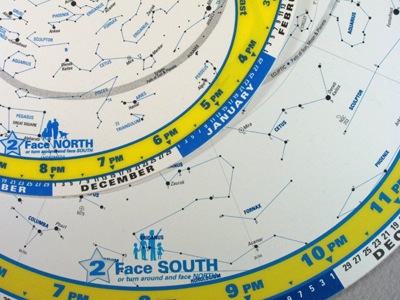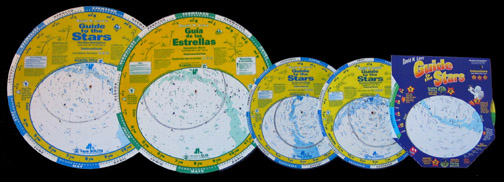Index of Books We Recommend
![]() Pricing
Pricing

Ken Press "David H. Levy Guide to the Stars"
The night sky is mapped with the Constellations being those patterns recognizable to man since time immemorial. Constellations can be thought of as countries or states on a world map, where if you seek the Grand Canyon then you know to find Arizona. While in the night sky when one seeks the Great Nebula then one looks toward the Constellation Orion. The Planisphere is the simplest device with which to start ones' trek into the night sky.
Martin Cohen, Company Seven


Above: Northern Hemisphere model front (151,843 bytes) with back shown at right (156,910 bytes).
The Milky Way in depicted in light blue, the Ecliptic is in gray, star names in black while other text is blue.
All writing is easy to read by day, and at night with a red flashlight.
Click on the image to view enlargements of the front (230,897) and back (304,763 bytes)
Among the most popular aspect of the "David H. Levy Guide to the Stars" are:
- easy to learn and use and with instructions printed on the back in case you are new or forget how to use it,
- impervious to the elements and durable,
- flexible,
- and in the large 16 inch (40.6 cm) diameter are easy to read when using a red light at night,
- it shows only those stars and some popular deep sky objects that are visible to the human eye or binoculars, with not much else to confuse you.
This device makes it very easy for one to find out what constellations and prominent deep sky objects are overhead at any given time of the day or night. And by knowing in what constellation a transient event is occurring (comet, nova, etc.) then one can use the Planisphere to seek it out, even marking the face of the chart with erasable marker. Just imagine, someday with your "David H. Levy Guide to the Stars" you could be the first person on your block to see the asteroid that will destroy the Earth!
How Does It Work? The Planisphere is a two piece plastic disc assembly with a map of the entire night sky (for the respective hemisphere) charted on the rear or chart disc. This chart is covered by an overlay disc which is attached by a rivet over the chart disc. The overlay is a mask with a transparent window presenting the areas of North, South, East and West horizons of the sky visible from the latitude where the Planisphere is made to work. The overlay can be dialed clockwise or counterclockwise to line up the overlay Time indicator with those of the Month and Day that are indicated around the edge of the rear chart disc. Once date and time are indexed then one will see those areas of the sky may be seen at any time of the year. Then it is a simple matter to hold the Planisphere overhead and line up the visible star patterns, or line up the perforation at the center of the dial with the Celestial Pole (near the star Polaris for example) and then line up the north horizon below.
This Planisphere is easy to use with the set up steps clearly explained on the overlay; 1 Align, 2 Face North (or South), etc. We prefer the larger 16 inch model in particular because the printing is larger than that on the 11 inch model, and easier to read. The print is black or blue lettering against a white background sky and is easy to read under red light. Constellations are shown with their imaginary lines making up their historic forms. The Milky Way is shown as a light blue cloud against the white background. The Ecliptic is in gray. The text identifies most of the popular stars, a listing of several galaxies and star clusters that can be seen naked eye, and more that are within the grasp of binoculars or a small telescope. Objects are selected and identified in ways so that clutter is reduced and clarity enhanced.
The back of the Planisphere provides an introduction by David Levy with some advice about how to find the popular deep sky objects. Advice about finding and observing the planets, the moon through its phases, meteor showers. David also provides some helpful hints regarding simple techniques about how to estimate angular dimensions, and how to proceed from the Planisphere. This is therefore more than a simple Planisphere and truly merits it's name "David H. Levy Guide to the Stars".
Which Hemisphere? There is one version of this Planisphere made for use with charts showing the night sky that may be seen in the Northern Hemisphere. This for by those located in latitudes between 30 to 60 degrees. This span of latitude includes: most of the US 48 contiguous states, parts of Canada, Europe and North Africa, much of the middle East, Asia and Japan.
The Planisphere made for use in the Northern Hemisphere would not work at all in Chile or Australia for example, and vice versa. Either model is not useful outside its given latitudes ranges, so for example we do not recommend the North model for use at location in the far north such as in Alaska or closer to the equator such as at Hawaii. We do offer one made for use the Southern Hemisphere which likewise is useless in the North. So if you ever plan to travel to another hemisphere then you should buy one for that location to since the skies there will be so different than those over your home.


Above: Graun 16 North Hemisphere planisphere overlaid with 11 inch Southern Hemisphere, and above at right close up (50,764 and 46,925 bytes).
Note how much easier it will be to read the lettering on the larger planisphere, especially under red light, than in the smaller model.
Click on images to see enlarged views (209,711 and 155,157 bytes).
When you buy a Planisphere we also recommend you buy our Rigel Skylite. This is a really handy user selectable red or white flashlight that makes it easier to set up and use the telescope or read charts at night under the red light without adversely affecting your night vision. The light may be dimmed as needed, and it's highly efficient Light Emitting Diode sources (3,000+ hours on one battery!) produce a nicely uniform beam of light, without brighter and darker areas typical of incandescent bulbs. If you need, you can also switch over to a very bluish white light for routine uses.
Available Models And Prices:


